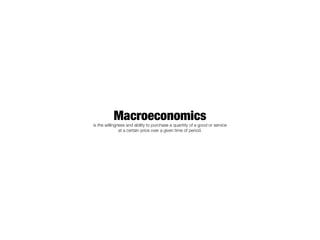Economic Essential Diagrams 2
- 1. Portfolio Semester Two
- 2. Market Failure is the failure of markets to produce at the socially efficient level of output.
- 3. Negative externality of consumption are the bad effects that are suffered by a third party when a good or service is consumed. Price ($) D = MPB S = MPC = MSC MSB P Welfare loss POPT Negative Externality O QOPT Q Quantity
- 4. Positive externality of consumption are the beneficial effects that are enjoyed by a third party when a good or service is consumed. Price ($) S = MPC = MSC Positive Externality Welfare gain POPT P MSB D = MPB O Q QOPT Quantity
- 5. Negative externality of production are the bad effects that are suffered by a third party when a good or service is produced. Price ($) D = MPB = MSB MSC S = MPC POPT Welfare loss P Negative Externality O QOPT Q Quantity
- 6. Positive externality of production are the beneficial effects that are enjoyed by a third party when a good or service is produced. Price ($) D = MPB = MSB S = MPC MSC Positive Externality P POPT Welfare gain O Q QOPT Quantity
- 7. Macroeconomics is the willingness and ability to purchase a quantity of a good or service at a certain price over a given time of period.
- 8. Circular Flow of Income is a simplified model of the economy that shows the flow of money through the economy. Households Savings Investment Government Taxes Income Expenditure spending Imports Exports Firms
- 9. Aggregate Demand is the total spending in an economy consisting of consumption, investment, government expenditure and net exports.
- 10. Rightward Shift in Aggregate Demand Average Price Level AS PL2 PL1 AD2 AD1 O Y1 Y2 Real GDP
- 11. Leftward Shift in Aggregate Demand Average Price Level AS PL1 PL2 AD1 AD2 O Y2 Y1 Real GDP
- 12. Aggregate Supply is the total amount of domestic goods and services supplied by businesses and the government, including both consumer goods and capital goods.
- 13. Rightward Shift in Aggregate Supply Average Price Level AS1 AS2 PL1 PL2 AD O Y1 Y2 Real GDP
- 14. Leftward Shift in Aggregate Supply Average Price Level AS2 AS1 PL2 PL1 AD O Y2 Y1 Real GDP
- 15. Long-run Aggregate Supply (Keynesian) Average Price Level LRAS O Real GDP
- 16. Long-run Aggregate Supply (Neo-classical) Average Price Level LRAS O Real GDP
- 17. Unemployment exists when workers are carrying out jobs for which they are over-qualified, that is they are not using their full skills and abilities or when workers are employed part-time, even though they are available for full-time employment or when workers in a planned economy are undertaking jobs that would not exist in a free market
- 18. Real wage unemployment is unemployment that exists when real wages (wages adjusted for inflation) in the economy get pushed up above their equilibrium, either by the government or by trade unions. Average real wage rate AS Unemployment { W1 W AD O Q1 Q Q2 Number of workers
- 19. Demand De?cient Unemployment is unemployment that exists when there is insufficient AD in the economy and real wages do not fall to compensate for this. Average real wage rate AS Unemployment { W W1 AD1 AD2 O Q1 Q Real GDP
- 20. In?ation is a sustained increase in the general level of prices and a fall in the value of money
- 21. Cost-push In?ation is inflation that is caused by an increase in the costs of production in an economy that shifts the SRAS curve to the left. Average Price Level SRAS2 SRAS1 PL2 PL1 AD O Y2 Y1 Real GDP
- 22. Demand-pull In?ation is inflation that is caused by increasing AD in an economy that shifts the AD curve to the right. Average Price Level SRAS PL2 PL1 AD2 AD1 O Y1 Y2 Real GDP
Editor's Notes
- \n
- \n
- \n
- \n
- \n
- \n
- \n
- \n
- \n
- \n
- \n
- \n
- \n
- \n
- \n
- \n
- \n
- \n
- \n
- \n
- \n
- \n






















